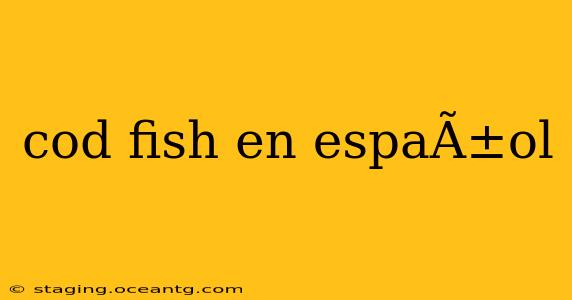"Cod fish in Spanish" is a straightforward search query, but the answer isn't quite as simple as one might think. While the most common translation is bacalao, there are nuances and regional variations to consider. This guide delves into the world of cod in Spanish, exploring different names, preparations, and cultural significance.
What is the most common word for cod fish in Spanish?
The most widely used and understood term for cod fish in Spanish is bacalao. This word is understood throughout the Spanish-speaking world and is used in recipes, markets, and everyday conversation.
What are other names for cod fish in Spanish?
While bacalao reigns supreme, regional variations and specific types of cod might lead to other names. For example, you might encounter terms like:
- Abadejo: This term is sometimes used interchangeably with bacalao, but it can also refer to other types of white fish. Context is crucial!
- Merluza: This refers to hake, a different, though similar, type of white fish. It's important not to confuse the two.
- Lenguado: This means sole, another flatfish distinct from cod.
What are the different types of bacalao?
The term bacalao itself can encompass several types of salted, dried cod. The preparation and origin of the cod can greatly impact its taste and texture. These distinctions are often important in Spanish cuisine:
- Bacalao al pil pil: This classic Basque dish utilizes fresh or rehydrated bacalao.
- Bacalao a la Vizcaína: A rich stew featuring bacalao, tomatoes, peppers, and onions.
- Bacalao confitado: A slow-cooked, melt-in-your-mouth preparation, often using olive oil.
How is bacalao prepared in Spanish cuisine?
Bacalao is incredibly versatile in Spanish cooking. It's used in a wide array of dishes, from simple preparations to elaborate stews. Common methods include:
- Salting and drying: This is a traditional preservation method, resulting in a firm, salty fish.
- Rehydration: The dried bacalao must be rehydrated before cooking. This process usually involves soaking the fish in water, often changing the water several times.
- Frying: Bacalao is often fried, resulting in a crispy exterior and a flaky interior.
- Stewing: Many stews incorporate bacalao as a key ingredient, adding a rich, savory flavor.
Is there a difference between bacalao and other white fish?
Yes, absolutely. While many white fish share similar textures and mild flavors, bacalao (specifically salted, dried cod) has a unique, intense flavor profile due to the salting and drying process. This makes it a star ingredient in many Spanish recipes. The texture also differs depending on preparation—it can range from flaky to almost melt-in-your-mouth tender.
Where can I find bacalao?
Bacalao is widely available in Spanish supermarkets, fishmongers, and even some international grocery stores. If you're looking for specific varieties or preparations, asking a fishmonger for recommendations is always a good idea.
This guide provides a comprehensive overview of cod fish in Spanish, highlighting the subtleties and variations inherent in the language and the diverse culinary traditions surrounding this important ingredient. Remember, the best way to truly understand the different terms and preparations is to explore Spanish cuisine firsthand!
